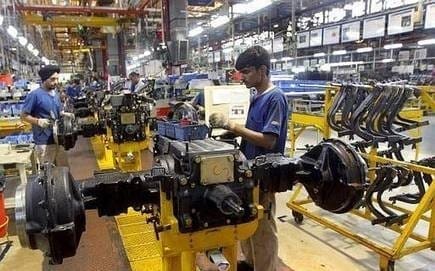Negative growth in all three segments of manufacturing, mining and power generation
In a further signal of a persisting slowdown, factory output contracted by 4.3 per cent in September hitting a seven-year low. Negative growth in all the three sectors of manufacturing, mining and electricity pulled down the Index of Industrial Production (IIP), which had recorded 4.6 per cent growth in the same month last year.
According to the Central Statistics Office (CSO) data, 4.3 per cent contraction is the deepest in the 2011-12 IIP series, which was unveiled in May 2017. In April 2012, the IIP had declined by 0.7 per cent. For the April-September 2019 period, the IIP grew a modest 1.3 per cent, lower than the 5.2-per-cent expansion in the same period last year.
The 5,2 per cent contraction in the core data for September, released on October 31, had suggested a steep drop in the IIP. While manufacturing — which has a weightage of 77.6 per cent — declined 3.9 per cent in September (it had grown 4.8 per cent in September 2018), mining — with a weightage of 14.4 per cent — contracted 8.5 per cent (up 0.1 per cent). Electricity generation contracted 2.6 per cent in September against a growth of 8.2 per cent in the same month last year.
As many as 17 of the 23 industry groups in the manufacturing sector contracted during September. Both consumer durables and capital goods, which are the major engines of growth, were in the negative both for September and the April-September period.
‘Indicative of stagnation’
Madan Sabnavis, Chief Economist, CARE Ratings, said the latest IIP print was a surprise though it was expected to be in the negative territory. He said the IIP growth in October will also be under pressure considering the high base effect of last year.
Sabnavis noted that cumulative growth in April-September 2019 at 1.3 per cent is very low and indicated stagnation. The negative growth in consumer goods is a disappointment and suggests consumer demand has not picked up as yet.
Capital goods declining again is indicative of downbeat investment, and will require some government push as the private sector is not investing, according to Sabnavis.
Rate-cut possibility
While there will be pressure on the RBI to lower rates, the CPI inflation number will need attention as food inflation has been rising and the Consumer Price Index is expected to be in the 4 per cent range.
AditiNayar, Vice-President and Principal Economist, ICRA, said the industrial performance in September stands out as the worst year-on-year performance in the current series. Moreover, the lead indicators point to the weakness continuing in October, which coupled with an unfavorable base effect, may well result in a further deterioration in the just-concluded month.
“While we had expected the IIP to contract in September 2019, it’s the pace of the same was deeper than our forecast of 3.3 per cent. Moreover, the contraction was widespread, covering all three sectors and five of the six use-based categories except intermediate goods,” Nayar added.

